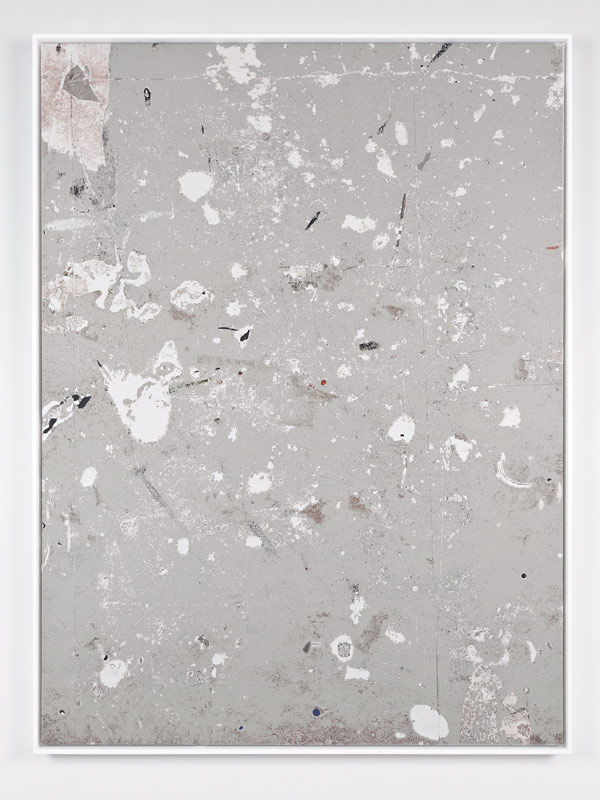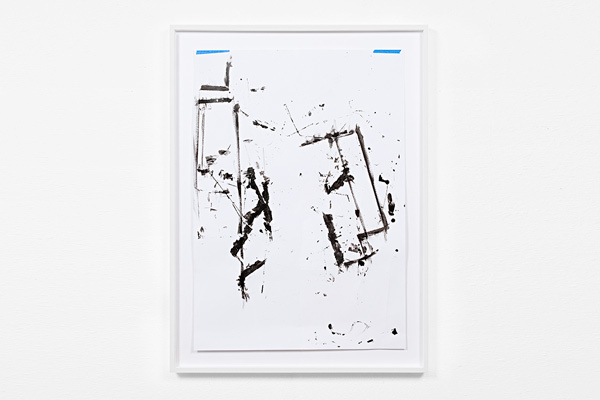
2012
120 x 90 cm
Mixed media on canvas.

2011
70×100 cm
Silkscreen Print on Paper
Edition of 5 (+ 2 AP)
The Fire Sermon I-III is a set of drawings extracted from the annotations and marks made by Ezra Pound in the draft for the modernist poem The Waste Land. By removing the underlaying text, these marks are rendered as abstract expressionistic drawings without any apparent motivation. – As every mark on the paper embodies a part of the original manuscript that was edited out or changed, these drawings are tempered and structured by the editors response to a text that these very same lines has made inaccessible to the viewer.

2011
Glass, Silicone, Plywood, MDF
130 x 55 x 22 cm
The Hyacinth Girl expands upon the conceptual framework initially explored in the sculpture Even a Velvet Rope Can Leave Its Rope Burns, employing the architectural structure of a window to raise questions about the nature of artistic interpretation. In The Hyacinth Girl, though, instead of permitting a view through the sculpture, the ‘window’ is mounted on a sheet of black wood. The dark background increases the glass’s reflectivity, and the glass panel, roughly the size and shape of a wall mirror, reveals the figure of the viewer. The double-paneled glass, set slightly away from the background, creates a sense of depth that complicates the reflection, both blurring it and giving the impression that the viewer is looking into the sculpture. The implication, that to contemplate art is to find ourselves within it, has a darker correlate: outward vision is illusory. And yet the title, The Hyacinth Girl, refers to one of the few figures of hope and beauty depicted in the desiccated and sinister Europe of T.S. Eliot’s The Waste Land. It suggests that the inherently introspective act of interpreting a work of art is not only productive but perhaps one of the only sincerely positive interactions possible in our culture.
Text by Amanda DeMarco

2011
Tape and Paint on Paper
97 x 72 cm
This work originated as the byproduct or refuse of the production of another piece. Used as an underlay for painting a sculpture not available to the viewer, it is at once a painting and something more, its imprints and outlines insisting on the existence of an object beyond the scope of the medium. As such, the paper becomes a surface onto which the viewer projects his or her notions of the absent object. Still, its value as an art-object in its own right is clearly asserted in its presentation. Though unpremeditated, the composition is striking, drawing energy from the tension between its fortuitous smears and drippings, and the diagrammatic, blue-print like outlines of the unknown sculpture. Lacking both the intentionality and the materiality of sculpture, No Better Cure Than Business is a vivid demonstration of the unilateral transformative power of the gaze in defining art. The title is a wry nod to the power of the art market and of artistic consumption to assign worth. What then is the value of labor or intent? Though the piece might be taken as an ironic illustration of the random nature of what we call art, or even a paean to unproductiveness and chance, it is also evidence of labor, a schema for the process of developing a vision. Indeed in some senses it is the embodiment of the artist’s labor, an unedited record of his motions.
Text by Amanda DeMarco

2011
Plywood, Timber, MDF, Glass
145x90x38 cm
Even a Velvet Rope Can Leave Its Rope Burns explores the relationship between artistic signification and the viewer’s capacity for individual reflection. The title alludes to the notion that the seemingly sterile appearances of modernist art and architecture can be an expression of something genuine and troubling. The minimalist construction, absent of color, is at once demanding and freeing. Taking the architectural form of a corner window, its traditional function as a transparent barrier is transmuted into a broader framework for the understanding of artistic encounters, which viewers must themselves complete with personal meaning. The window becomes an object which itself can be employed as a surface onto which the observer’s reflections are projected. This new unadorned structure is stripped of such concepts as ‘interior’ or ‘exterior,’ requiring a reinvention of even the most basic points of reference. As much as the piece has the shape of a corner window, it also has the form of an open book and points to the ways in which interpreting any work of art involves confronting a barrier and moving beyond it. Indeed, the barrier is the condition for reaching new ways of seeing and thinking.
Text by Amanda DeMarco

2011
Framed plaster board, paint
134x94x7 cm
A circular cut is made in a plasterboard panel containing a black circle, thereby separating the circular element from the rectangular format of the panel. Rather than being removed, the disc is rotated on its own axis. In order to fit into the frame, the edge of the plasterboard is trimmed away such that the circle becomes locked into position, preventing any further movement. The final composition is thus defined. Whereas the work can be formally linked to constructivism and to Gordon Matta-Clark’s architectural interventions, the title connects it to TS Eliot and his critique of modernity in the poem The Waste Land.

2011
Jesmonite, Fibreglass
550 x 180 cm
Frank Stella’s shaped stripe paintings provide the point of departure for Sande’s On the Inclination Towards Restrained Affinity and the Transubstantiation of Love, which imagines the fictional back side of such a canvas from the V series. By reproducing the structures invisible to viewers in museums or galleries, Sande creates reveals a perspective normally closed to the public and insists on the physicality of the work.
The repetitive stripes of Stella’s original already imply the concept of mass reproduction. Similarly, On the Inclination Towards Restrained Affinity and the Transubstantiation of Love is composed of a single repeated v-shaped module. However, in Sande’s work the idea of reproduction is reflected and refracted upon itself in troubling new ways.
Whereas mechanical reproduction results in a Benjamin-esque loss of aura, Sande’s hand-made plaster reproduction implies physical intimacy, mimicking Stella’s own gestures (which, for as precise as they appear, were also painted by hand). Through this careful remaking, the original work becomes both personal and iconic, the specific creation that gives rise to the reproduction.
Plaster suggests the traditional academic study of a master, and the act of reproduction is thus reconnected to its role in interpretation, education, and the transmission of artistic ideas. Rather than being devalued, the work and its aura are in many senses elevated.
Text by Amanda DeMarco

2010
Plasterboard, paint, filler
165 x 110 cm